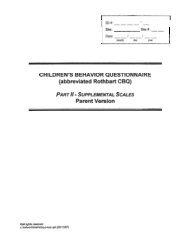A Contextual Investigation of Three-Digit Addition and Subtraction
A Contextual Investigation of Three-Digit Addition and Subtraction
A Contextual Investigation of Three-Digit Addition and Subtraction
Create successful ePaper yourself
Turn your PDF publications into a flip-book with our unique Google optimized e-Paper software.
142 THE TEACHING AND LEARNING OF ALGORITHMS IN SCHOOL MATHEMATICS<br />
approach <strong>and</strong> traditional instruction is captured by the difference between “How can I<br />
figure this out?” <strong>and</strong> “What was I told I was supposed to do?” (Yackel et al. 1990). In<br />
the approach we will discuss, relational underst<strong>and</strong>ing occurs as teachers systematically<br />
support students’ construction <strong>of</strong> personally meaningful algorithms. These algorithms<br />
emerge when students engage in sequences <strong>of</strong> problem-solving activities designed<br />
to provide opportunities for them to make sense <strong>of</strong> their mathematical activity.<br />
An immediate consequence <strong>of</strong> this focus on algorithms as symbolizing numerical relationships<br />
is that it precludes the unreasonable answers that <strong>of</strong>ten occur from the misapplication<br />
<strong>of</strong> little-understood st<strong>and</strong>ard algorithms.<br />
To clarify our viewpoint, we will present episodes taken from a third-grade classroom<br />
in which we conducted a nine-week teaching experiment. (The authors <strong>of</strong> this<br />
paper were all members <strong>of</strong> the research team involved in the teaching experiment. The<br />
first author was also the classroom teacher who appears in the episodes in this paper.)<br />
One <strong>of</strong> the goals <strong>of</strong> the experiment was to develop an instructional sequence designed<br />
to support third graders’ construction <strong>of</strong> increasingly sophisticated conceptions <strong>of</strong><br />
place-value numeration <strong>and</strong> increasinalv efficient algorithms for adding <strong>and</strong> subtracting<br />
three-digit numbers. Our intent is not to <strong>of</strong>fer examples <strong>of</strong> exemplary teaching but<br />
instead to provide a context in which to examine the relationship between numerical<br />
underst<strong>and</strong>ing <strong>and</strong> the use <strong>of</strong> powerful algorithms. In addition, the episodes will illustrate<br />
how students’ beliefs about mathematics in school influence their development <strong>of</strong><br />
personally meaningful algorithms. In the following sections <strong>of</strong> this paper, we will first<br />
outline the instructional sequence developed in the course <strong>of</strong> the experiment <strong>and</strong> then<br />
focus on the students’ algorithms <strong>and</strong> their beliefs.<br />
THE INSTRUCTIONAL SEQUENCE<br />
The instructional sequence we designed to support the development <strong>of</strong> underst<strong>and</strong>ing<br />
<strong>and</strong> computational facility in an integrated manner centered on the scenario <strong>of</strong> a<br />
c<strong>and</strong>y factory. The activities initially involved Unifix cubes as substitutes for c<strong>and</strong>ies<br />
<strong>and</strong> later involved the development <strong>of</strong> ways <strong>of</strong> recording transactions in the factory (cf.<br />
Cobb, Yackel, <strong>and</strong> Wood [1992] <strong>and</strong> Bowers [1995]). During initial whole-class discussions,<br />
the students <strong>and</strong> teacher negotiated the convention that single pieces <strong>of</strong> c<strong>and</strong>y<br />
were packed into rolls <strong>of</strong> ten <strong>and</strong> ten rolls were packed into boxes <strong>of</strong> one hundred. The<br />
ensuing activities included tasks in estimating <strong>and</strong> quantifying designed to support the<br />
development <strong>of</strong> enumeration strategies. These activities involved showing the students<br />
drawings <strong>of</strong> rolls <strong>and</strong> pieces with an overhead projector <strong>and</strong> asking them to determine<br />
how many c<strong>and</strong>ies there were in all. In addition, the students were shown rectangular<br />
arrays <strong>of</strong> individual c<strong>and</strong>ies <strong>and</strong> asked to estimate how many rolls could be made from<br />
the c<strong>and</strong>ies shown. Instructional activities developed later in the sequence included






